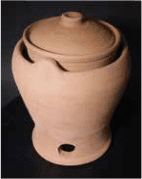Granaries were an important feature of all Roman forts. They housed the grain for the troops and fodder for the horses. Each fort was supposed to hold a year’s supply of food in case it fell under siege. Granaries had raised floors to keep the food dry and fresh.
At Bearsden, the only buildings not made of timber within the fort were two stone granaries. There is evidence to suggest that at least on one of the structures the roof was made of tiles. The total floor area of the granaries was 105.4m². This means that between them they could have provided grain to feed nearly 400 men! This however doesn’t include what would have been needed for the horses.
Romans loved their food. On the Antonine Wall, they received deliveries of olive oil, wine, spice and wheat from as far away as Spain and Germany. Their diet was mainly plant based. Two different types of wheat have been found at Bearsden. Spelt for baking bread and emmer for making porridge. Residues in pots also showed evidence of durum wheat, which could have been used for making pasta. There was no communal canteen. Soldiers prepared, cooked and ate in their barrack rooms. They ate their food out of pottery bowls using their fingers.

Here at Bearsden, soldiers were cooking on braziers (little portable cookers) and with casserole dishes that were north African in style. They cooked and ate communally, helping one another and sha-ring both resources and work.
The biggest, most awe-inspiring building project the people of Scotland had ever seen, the Antonine Wall stretched right across the country, from Clyde to Forth. Visit us to learn more.


